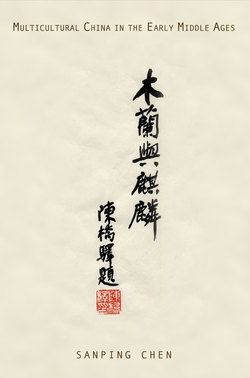Читать книгу Multicultural China in the Early Middle Ages - Sanping Chen - Страница 8
ОглавлениеIntroduction
On the afternoon of July 30, 1980, three Chinese historians discovered, on a granite rock face inside a stone cavern in the Xing'an Mountains in northeast China (more exactly at 50°38'N, 123°36'E), an inscription dated September 5, 443, by far the most ancient sample of writing in this part of Asia.1 This important discovery, or rather confirmation, of the inscription's existence not only helped identify the original homestead of the Tuoba, an ancient nomadic people and the main subject of this book, but also vindicated the accuracy of Wei shu (History of the [Tuoba] Wei Dynasty), previously considered one of the least reliable Chinese dynastic histories.
However, a seemingly minor discrepancy or rather neglect by the text preserved in Wei shu as compared with the actual inscription indicates that, after establishing themselves as the undisputed masters of northern China, the Tuoba monarchs were still known by their nomadic designation qaghan instead of the Chinese title huangdi, or “son of heaven.” This distinction would serve as an important clue to the Tuoba's lasting legacy expounded in this book, as well as a good example of what I would term a Confucianist bias in the written sources on which most of our understanding of the period is based.
The Tuoba first appeared in the history of East Asia as a marginal nomadic group in the second half of the third century. From the beginning, they were regarded as part of the general Xianbei complex or conglomerate, the new dominating yet largely decentralized nomadic power in northern Asia. The Xianbei had displaced the Xiongnu, widely regarded as the forerunners of the Huns who would terrorize Europe several centuries later.
The Tuoba rose to prominence in the late fourth century, especially strong after they destroyed the main forces of the rival Murong power, then the leading Xianbei group in northern China, on December 8, 395, in a superbly executed surprise pursuit under the energetic and daring leadership of the young Tuoba Gui (371–409). Eight months after this decisive military victory, the Tuoba chief formally adopted the Chinese imperial protocol. On this juncture of history, the Yuan dynasty historian Hu Sanxing (1230–1302), in his famous annotated edition of Sima Guang's immortal Chinese chronology Zizhi tongjian (Comprehensive Mirror for Aid in Government, abbreviated in this book as ZZTJ), made the following incisive comments: “The rise of Tuoba Gui led to the hardening of the North-South partition, which in turn led to the eventual absorption of the South by the North. Alas, from the Sui era onward, sixty to seventy percent of those who were prominent in their times have been descendants of the Tuoba [and other Xianbei and Xiongnu groups led by the Tuoba]!”2
In other words, from this point on, the Tuoba and their descendants pretty much set the course of Chinese history, not just politically but also culturally, for nearly a millennium before another nomadic people, the Mongols, swept much of the Asian continent. A reader otherwise well versed in Chinese history may wonder why such an important group was not heard of more frequently in all of the very large volume of history about China. This good question is just one of several issues the current collection tries to address.
Another subject that is often neglected, particularly in comparison with that of the Mongol era, is how these earlier “Barbarian” invasions greatly stimulated the movements of peoples, commodities, and, not least, ideas across the Eurasian continent in the ancient world, especially along but not limited to the Silk Road. In my view, the well-known and much studied cosmopolitanism of the Tang dynasty was the culmination of a chain of events to which the Tuoba had been a major contributor yet for which they have heretofore received little recognition.
The prevailing perceptions of the two most cosmopolitan periods in China's premodern history, namely the Tang and the Yuan, are sharply different. The former is viewed as the accomplishment of an enlightened but largely native Chinese regime, whereas the latter is regarded as the outcome of the conquest of China by a nomadic power. One of the main reasons for this difference is the Sinitic façade the Tang (and its cousin the Sui) royal house had successfully woven for itself, obscuring the family's ethnic and cultural origin and identity. Thus the ethnic identity of the Tang house becomes one of the topics of this collection.
The Tang dynasty, at least during its prime, witnessed unprecedented cultural openness and tolerance, matched only by that of the Mongol Yuan. The best example is the flourishing, albeit not for long, of several foreign religions: Zoroastrianism, Manichaeism, Nestorian Christianity, and finally the establishment of Buddhism in China. There were other important cultural imports and changes. Many are well known and well studied. But some, like the advent and wide adoption of theophoric names, both personal and institutional, have never been noted by historians. No less important, these epochal events can all be traced back to the Tuoba roots of the Sui and Tang houses when one examines numerous earlier cases during the rule of northern China by the Tuoba and its nomadic brethren and/or successors. These cases demonstrate that China's extraordinary cosmopolitanism of that period was in fact driven by factors similar to those evident during the Mongol Yuan.
All in all, these subjects merit a full-fledged treatise. While the pursuit of such a large, complete study remains my desire, in this book I offer only a collection of specific studies of various aspects and hope such a piecemeal product will stimulate further interest and exploration in this fascinating area and epoch.
